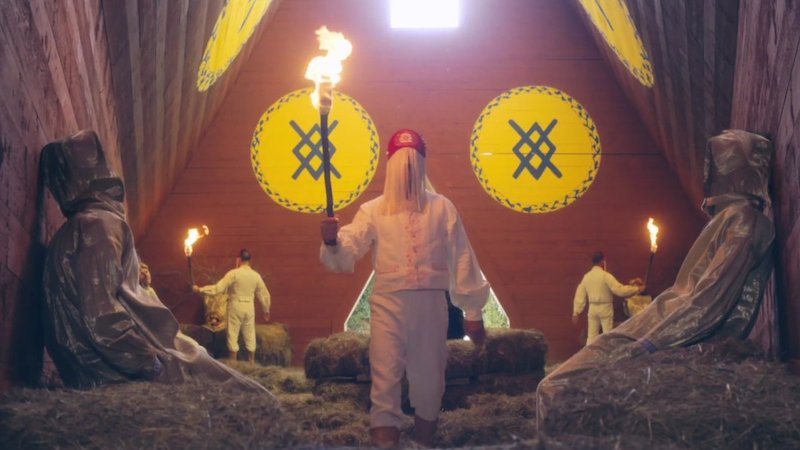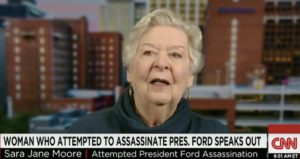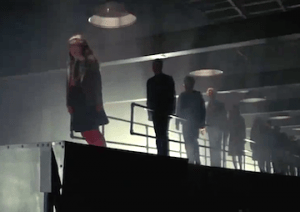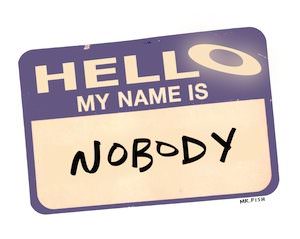In ‘Midsommar,’ Silent White Supremacy Shrieks Volumes
It isn’t a vision of Coachella gone horribly awry—the summer hit draws its scares from racialized terror campaigns from past and present. Whiteness equals darkness: a cultish scene from "Midsommar." (IMDb)
Whiteness equals darkness: a cultish scene from "Midsommar." (IMDb)
Warning: Spoilers abound.
“Midsommar” might just be the movie of the summer. Writer-director Ari Aster’s visually stunning day-lit nightmare follows four Americans on a journey to a pagan commune in rural Sweden as they observe a summer solstice festival replete with ritual human sacrifice.
Viewers are lining up in droves to take the trip with them. Whether in online forums or in bars and cafes catering to the intellectual and artistic in cities like Los Angeles and New York, people can’t seem to stop talking about this beautiful and sinister tale of grief, breakups and murder.
Yet in the dozens of reviews about the film, few have acknowledged or appear to have even noticed that the world of the Hårga—the Scandinavian cult at the center of the film—is a white supremacist’s wet dream. Based on mostly overlooked comments by Aster, the film may even intentionally be a satire of the neo-pagan and anti-immigrant teachings employed by some on the far right.
From the moment Mark (the fool, played by “The Revenant” actor Will Poulter), Christian (the clueless boyfriend, portrayed by Jack Reynor of “On the Basis of Sex”), Josh (the obsessive anthropology student depicted with typical flair by William Harper Jackson of “The Good Place”) and Dani (the film’s anti-heroine and eventual May queen, played by newcomer Florence Pugh) enter Hårga’s runic sun gate, whiteness envelops the screen. As noted by Pelle, the commune-raised foreign exchange student who brought the Americans to the village, we are now in the land of the midnight sun.
From the dizzying and near-perpetual sunlight to the clothes worn by the Hårga, whiteness symbolizes the unity of the cult. Color, on the clothes of the outsiders and especially on the skin of Josh and British visitors Connie (played by Ellora Torchia) and Simon (Archie Madekwe), is an instant visual cue of otherness.
As the director pointed out in an interview with the New York Daily News, the Hårga’s treatment of the film’s characters of color stems from their racism.
Josh is not the first person to be killed off, seemingly subverting the “black guy dies first” trope, as the Daily News notes. But Simon, a black (albeit lighter-skinned) British friend brought to the commune by Pelle’s brother Ingemar, is the first character killed. He’s soon followed by Connie, his fiancée.
These outsiders, viewers learn, are brought to the Hårga for the purposes of mating and/or sacrificing. The way recruits are chosen for these roles, Aster reveals in his Daily News interview, is also a callback to “a part of Swedish history and European history” that is explicitly racist. The director adds that the Hårga only recruit white people as “new blood” for the cult.
Josh, Aster says, is “thrown away in a way that the other members of the main cast are not. And that is because these people have no further use for him.”
Perhaps the most overt admission of racism in “Midsommar” comes as something of an aside, just before the climactic maypole dance competition that leads to Dani’s crowning as the May queen.
As a red-cheeked and rotund Hårga woman explains to the assembled crowd in Swedish, the commune observes the maypole dance tradition during its midsommar festivities to spite “the Black One,” who, some time in the distant past, put a spell on the women that caused them to dance in a frenzy until they died. The explanation provides a rare glimpse into the cult’s dogma, and although this “Black One” is, presumably, an allusion to a devil or demon, it sounds particularly harsh and bigoted in the guttural Swedish of this white linen-clad milkmaid.
Josh, as the darkest-skinned of the cast, is indeed scapegoated after being murdered when he was caught in the act of taking forbidden photos of the cult’s sacred runic text. To explain his disappearance, an elder tells commune members that their holy book is missing. He implies that the culprit was either Josh or Mark (the laconic white jokester of the American bunch, who is seduced by a Hårga girl, possibly for the purpose of inseminating her, then killed and skinned). Christian, clearly on his way to indoctrination, throws Josh under the bus—a move the elders are more than happy to exploit.
Were it just the mistreatment of the black and brown characters and weird dark-skinned devil imagery in the Hårga’s mythology, it would be easy enough to write off the cult’s racism as a sign that it bought into an antiquated European obsession with purity. It enters full-on white supremacist territory, however, when it comes to the basis of the Hårga’s strange breath-language and the markings around their village—Nordic runes.
Any metal fan or researcher specializing in hate groups can tell you that there is a specific subset of neo-Nazis in both Europe and North America who are utterly obsessed with Nordic mythology. Odin, the Zeus-like king of the Nordic pantheon, is popularly co-opted by such white supremacist groups as the Soldiers of Odin, and many modern neo-Nazis practice perverted Norse religions that use the hammer of Thor as an identifying symbol.
Be it the black sun rune popularized by pre-World War II Nazis (and seen on shields at the deadly 2017 Unite the Right rally in Charlottesville, Va.) or the Othala, or Odal, rune that’s used for everything from white supremacist tattoos to group logos, it’s impossible to watch “Midsommar” with an understanding of Nazi runic obsession and believe it was unintentionally incorporated into the film. Indeed, the half-sun gate at the entrance to the commune’s compound resembles the black sun rune, and the Odal is seen on at least one item of Hårga clothing.
It must be noted that the Hårga recruitment and sacrifice scheme is an inversion of the classic anti-immigrant argument employed by white nationalists—instead of trying to keep the dark-skinned Other out, the cult deliberately brings people in. Of course, its motives are less than liberal.
Josh, as the scapegoat and sacrificial victim, represents another subversion of the racist trope that paints people of other races as unwilling to assimilate. He, more than any other member of his travel party, is fascinated by the Hårga—so much so that he intends to incorporate them into his thesis on European midsummer traditions.
Need further proof that the film is a deliberate callback to and satire of the world white supremacists want? Look no further than its reception from white supremacists themselves.
“Oh look,” white nationalist Lana Lokteff tweeted soon after the trailer for the film was released in March. “A horrible film demonizing an ancient Swedish/European tradition where pretty peaceful Swedes are racist killers. Edgy stuff.”
“How about a film in Israel showing the horror of an Orthodox Jewish tradition, Ari Aster,” she added, a probable reference to the director’s Jewish background. “No surprise Ari made a film about incest too. Sick mind.”
Oh look a horrible film demonizing an ancient Swedish/European tradition where pretty peaceful Swedes are racist killers. Edgy stuff.
— Lana (@LanaLokteff) March 8, 2019
How about a film in Israel showing the horror of an Orthodox Jewish tradition, Ari Aster. No surprise Ari made a film about incest too. Sick mind. https://t.co/OGtBaMJMs6
Henrik Palmgren, Lokteff’s Swedish-born husband, also had a lot to say about “Midsommar” depiction of rituals in his home country.
As noted by Angry White Men, a blog dedicated to tracking white nationalist and white supremacist internet personalities, Palmgren complained on the vlog he shares with Lokteff that the film is “clearly a hate movie” that represents “racial discrimination against people of—especially Nordic heritage, but white people in general.”
After an anti-Semitic diatribe in which he complains that Aster is creating “propaganda,” the host bizarrely claims that the portrayal of Swedes in the film are worse than caricatures of Jews published by the Nazi newspaper Der Stürmer during Adolf Hitler’s rise to power.
From Aster’s comments about Hårga racism to the blink-and-you’ll-miss-it inclusion of a book titled “The Secret Nazi Language of the Uthark” before the group sets off for Sweden, “Midsommar” includes far too many neo-Nazi Easter eggs for the apparent racist allegory to be coincidental.
As The Stranger reviewer Joule Zelman writes, “While the Swedish cultists—who all learn a runic language as children—aren’t necessarily white supremacists, it’s not a stretch to view ‘Midsommar’ as a warning.”
Your support matters…Independent journalism is under threat and overshadowed by heavily funded mainstream media.
You can help level the playing field. Become a member.
Your tax-deductible contribution keeps us digging beneath the headlines to give you thought-provoking, investigative reporting and analysis that unearths what's really happening- without compromise.
Give today to support our courageous, independent journalists.









You need to be a supporter to comment.
There are currently no responses to this article.
Be the first to respond.